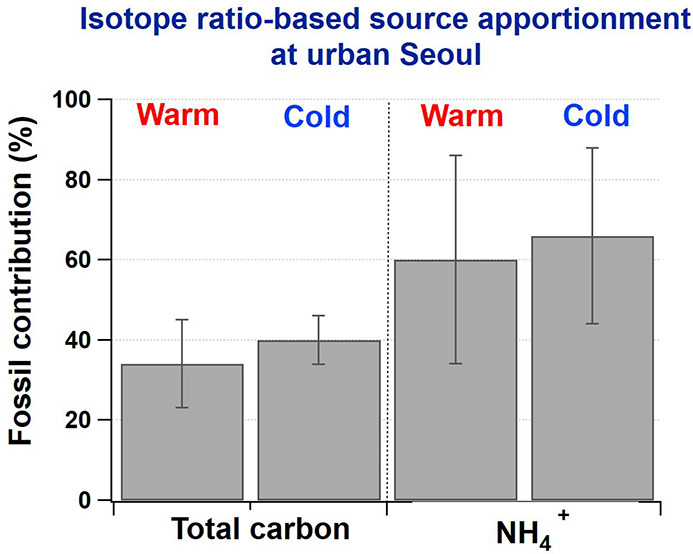- Record: found
- Abstract: found
- Article: found
Robust Evidence of 14C, 13C, and 15N Analyses Indicating Fossil Fuel Sources for Total Carbon and Ammonium in Fine Aerosols in Seoul Megacity

Read this article at
Abstract

Carbon- and nitrogen-containing aerosols are ubiquitous in urban atmospheres and play important roles in air quality and climate change. We determined the 14C fraction modern ( f M) and δ 13C of total carbon (TC) and δ 15N of NH 4 + in the PM 2.5 collected in Seoul megacity during April 2018 to December 2019. The seasonal mean δ 13C values were similar to −25.1‰ ± 2.0‰ in warm and −24.2‰ ± 0.82‰ in cold seasons. Mean δ 15N values were higher in warm (16.4‰ ± 2.8‰) than in cold seasons (4.0‰ ± 6.1‰), highlighting the temperature effects on atmospheric NH 3 levels and phase-equilibrium isotopic exchange during the conversion of NH 3 to NH 4 +. While 37% ± 10% of TC was apportioned to fossil-fuel sources on the basis of f M values, δ 15N indicated a higher contribution of emissions from vehicle exhausts and electricity generating units (power-plant NH 3 slip) to NH 3: 60% ± 26% in warm season and 66% ± 22% in cold season, based on a Bayesian isotope-mixing model. The collective evidence of multiple isotope analysis reasonably supports the major contribution of fossil-fuel-combustion sources to NH 4 +, in conjunction with TC, and an increased contribution from vehicle emissions during the severe PM 2.5 pollution episodes. These findings demonstrate the efficacy of a multiple-isotope approach in providing better insight into the major sources of PM 2.5 in the urban atmosphere.
Abstract
δ 15N of NH 4 + and f M and δ 13C of TC highlight the importance of vehicle emissions to the PM 2.5 mass increase in Seoul.
Related collections
Most cited references101
- Record: found
- Abstract: found
- Article: not found
Evolution of organic aerosols in the atmosphere.
- Record: found
- Abstract: not found
- Article: not found
NOAA’s HYSPLIT Atmospheric Transport and Dispersion Modeling System
- Record: found
- Abstract: not found
- Article: not found